

Book Review: “Greco-Arab and Islamic Herbal Medicine: Traditional System, Ethics, Safety, Efficacy and Regulatory Issues”
by Salim Al-HassaniPublished on: 8th June 2020
Traditional Arab-Islamic* herbal medicine plays an increasingly influential role in modern Western medicine. This extensive work addresses the need for a comprehensive, English-language work on the subject, introducing an important academic treatment of Arab herbal medicine. The authors offer a unique introduction to various details using original ethnopharmacological surveys they conducted in the Mediterranean region. Drawing on expertise in pharmacology, cell biology, and immunology, they combine scientific knowledge with herbal wisdom, discussing the full range of topics, from historical overview to Arabic medical principles. They put special emphasis on the potential use of Arab herbal medicines in modern drug discovery and therapies. The work attempts to uncover the role of Islamic scholars of the Golden Age of the Muslim civilisation and recognises their contributions to the rise of early modern western medicine.
* The term Arab-Islamic is used by the authors. It becomes clearer in the book that the intention of the authors is to recognise all Muslim and non-Muslim contributors from the Muslim world.

***
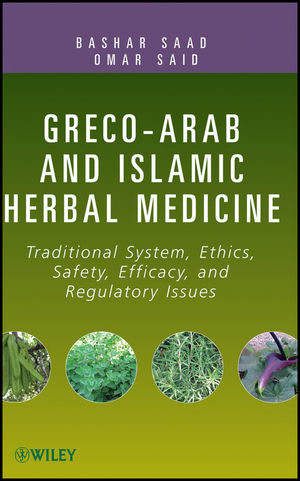
This is a review of the book published by Wiley-Blackwell John Wiley & Sons, Inc in 2011, authored by Bashar Saad and Omar Said. Titled “Greco-Arab and Islamic Herbal Medicine: Traditional System, Ethics, Safety, Efficacy and Regulatory Issues”.
***
Currently and despite the great progress in modern medicine, traditional Arab-Islamic medicine continues to be practiced within the Mediterranean as well as most Arab and Islamic countries. A very important factor that enhanced the present popularity and widespread use of Arab herbal-based medicines is the belief that they are prepared according to the principles of Greco-Arab and Islamic medicine, which was developed during the Golden Age of Muslim civilization.
This civilization spanned from the seventh to fifteenth century and extended from Spain and Portugal to Central Asia and India. It became a wellspring of brilliant medical developments and innovations, as well as of great achievements in astronomy, mathematics, chemistry, philosophy, and the arts. Scientists significantly contributed to the development of modern Western medicine, accomplishing far more than mere translation.

Development of medical science. Mesopotamian medicine was transmitted in part to the Greeks, and together with Egyptian medicine, it paved the way for the great Hippocratic reform. Then, during the rise of the Arab–Islamic Empire, Greek medicine was translated to Arabic. The Arabs improved on Greek medicine as well as made new discoveries over several centuries. In the thirteenth and fourteenth centuries, medicine was disseminated to Europe again from Arab capitals such as Cordoba and Baghdad. (Source: Figure 2.1 from the book)
A closer look at their activity during the medieval period shows that they translated classical medical texts not only from Greece, but also from Persia, India and China. From this, scientists from Muslim civilisation were able to synthesize and develop a rich and universal medical system, based on scientific methods and experimentation. The works of scholars gained widespread use and were used in European medical schools. For instance, the physicians Al Tabbari, Al Razi (Rhazes), Al Zahrawi (Albucasis), Al-Biruni, Ibn Sina (Avicenna), Ibn al Haitham (Al Hazen), Ibn al Nafees, Ibn Khaldun, and Ibn Zuhr (Avenzoar) are regarded as among the great medical authorities of the ancient world and medieval world, physicians whose textbooks were used in European universities up to the sixteen century. They were among the first to make accurate diagnoses of plague, diphtheria, diabetes, gout, cancer, leprosy, rabies, and epilepsy. The works of Ibn Sina (Avicenna) and Al Razi (Rhazes) on infectious diseases led to the introduction of quarantine as a means of limiting the spread of these diseases. These polymath physicians laid down the principles of clinical investigation and drug trials, and animal tests. They mastered operations for hernia and cataracts, filled teeth with gold leaf and prescribed spectacles for defective eyesight.
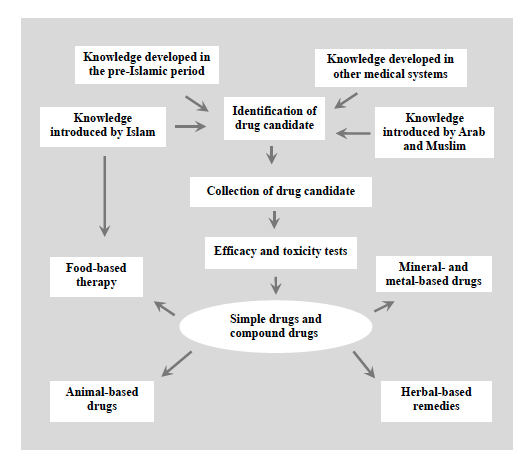
Drug discovery in Greco-Arab and Islamic medicine. Selection of potential natural products was based on (1) knowledge developed traditional healers in the pre-Islamic period based on a long history of trial and error; (2) knowledge introduced by the Islam; (3) Greek and Persian medical knowledge; and (4) theoretical and practical knowledge introduced by Arab and Muslim scholars. At present, herbal-based drug discovery continues to provide new and important leads against various ailments, for example, cancer, psoriasis, diabetes, malaria, and pain. With only 5–15% of the approximately 250,000 species of higher plants systematically investigated, and the potential of the marine environment barely tapped, these areas will remain a rich source of novel bioactive compounds (Source: Figure 6.1 from the book)
The physicians and scientists of the Islamic Golden Age, who were of diverse religious and ethnic backgrounds, passed on rules of health, diet and hygiene that are still largely valid today.
The high degree of development achieved in Greco-Arab and Islamic medicine is observable in a statement of Ibn Sina (Avicenna) (980-1037), who defined medicine in his Canon of medicine as
“the science from which we learn the states of the human body with respect to what is healthy and what is not; in order to preserve good health when it exists and restore it when it is lacking.“
He further stated that
“we have to understand that the best and most effective remedy for the treatment of patients should be through the improvement of the power of the human body in order to increase its immune system, which is based on the beauty of the surroundings and letting him listen to the best music and allowing his best friends to be with him.”
Another statement concerning therapeutic methods was made by Al Razi (Rhazes) (846-930):
“if the physician is able to treat with foodstuffs, not medication, then he has succeeded. If, however, he must use medications, then it should be simple remedies and not compound ones.”
Medical practice in the Muslim world influenced Western medical circles to such an extent that it was included in the curriculum of European medical schools for many centuries.
This book is well placed to be the best academic book in the field of herbal medicine that explores and introduces Arab herbal medicine aspects using original ethnopharmacological surveys conducted by the authors’ group in the Mediterranean area. In the course of their 19 chapters the authors, reveal the complexities, encourage comparisons, and offer answers to questions such as: How did Arab-Islamic medicine reach such high levels of knowledge and practice? How did scholars lay the foundations of modern Western medicine and pharmacology? How did Arab physicians discover and successfully treat diseases and how did they lay the foundations for clinical trials and animal testing? And finally, the authors give an overview of currently used medicinal plants in the contemporary Arab world and their efficacy and safety. The authors organized their book around nineteen major topics, reflected by the titles of these chapters:
- An overview of Greco-Arab and Islamic medicine,
- History of Arab and Islamic medicine,
- History of Arab and Islamic herbal medicine,
- Common roots of Arab medicine and Western medicine,
- Contributions of Arab and Islamic Scholars to modern pharmacology,
- Methodology of drug discovery in Arabic and Islamic medicine,
- Method of therapy in Arabic and Islamic medicine,
- Commonly used herbal medicines in the Mediterranean,
- The current state of knowledge of Arab herbal medicine,
- Arabic and Islamic medicine practiced outside the Middle East,
- Biosafety of Arab herbal medicine,
- Arab medicinal plants from traditional uses to scientific knowledge,
- Modern in vitro test systems,
- Modern in vivo evaluation and clinical trials of traditional Arab herbal medicine,
- Medical ethics in Arabic and Islamic medicine,
- The uses of medicinal herbs and extracting their active ingredients,
- Food therapy,
- Arab herbal remedies: Use, demographic, regulatory issues, and
- Drug development from herbal sources.

Diseases and Commonly used medicinal plants. Herbs are used either in their crude forms or as herbal teas, syrups, infusions, and powders in treatment and prevention of diseases. Efficacy and safety medicinal plants in this diagram are discussed in detail in Chapters 8 and 12. (Source: Figure 3.1 from the book)
The authors provide in chapter 8 an overview of traditional uses, safety, and efficacy of commonly used herbal medicines where more than 3600 plant species are found and about 450 plants are noted for their uses as medicinal herbs. Plant parts used included leaves, flowers, stems, roots, seeds, and berries. In order to reduce the confusions of common names, which can refer to different plants depending on the region where they grow, we used Latin names as well as common Arabic names and common English names. To keep within the scope of this chapter they briefly mention the most commonly used medicinal plants in the Mediterranean region.
Based on scientific and traditional knowledge, there is little doubt that the concept of Greco-Arab and Islamic herbal medicinal therapy has shown recognised success in healing acute as well as chronic diseases. The authors purport that Physicians from the Muslim civilisation were the first to use scientific methods in the field of medicine, including the introduction of quantification, animal testing, and clinical trials. Hospitals in the Arab-Islamic world featured the first drug tests, drug purity regulations, and competency tests for physicians. They denote that the earliest known medical experiment was carried out by Al Razi (Rhazes) (865 – 925). In order to locate the most hygienic place to build a hospital, he hung pieces of meat in places throughout Baghdad and built the hospital where the meat decomposition was the least. In his Comprehensive Book of Medicine, Al Razi (Rhazes) documented clinical cases of his own experience and provided very useful recordings of various diseases. He also introduced urinalysis and stool tests. They report that Ibn Sina (Avicenna) (980-1037) introduced experimental medicine and systematic experimentation and quantification in physiology. He discovered the contagious nature of diseases, and described many medical treatments, including clinical trials, risk factor analysis, and the idea of a syndrome in the diagnosis of specific diseases. His book, The Canon of Medicine, was the first book dealing with evidence-based medicine, randomized controlled trials, and efficacy tests. Concerning medical documentation, the first documented description of a peer review publication process was written by Ishaq bin Ali al-Rahwi (854–931). In his work, the Ethics of the Physician, he stated that a physician must always make duplicate notes of a patient’s condition. When the patient was cured or had died, the notes of the physician were examined by a local medical council of other physicians, who would review the practicing physician’s notes to decide whether the treatment has met the required standards of medical care.
The authors refer to a Hadith (saying of Prophet Muhammad), the stomach is the central basin of the body and origin of many diseases:
“The stomach is the central basin of the body, and the veins are connected to it. When the stomach is healthy, it passes on its condition to veins, and in turn the veins will circulate the same and when the stomach is putrescence, the veins will absorb such putrescence and issue the same.”
Indeed, the Prophet used to recommend food for ailments even more than herbs or animal-based medicines. He used everything from barley soup to honey to camel milk to heal his followers and advised them to eat certain foods to prevent or cure other diseases. In fact, diet is one of the oldest and most respected healing agents available to man. Honey, camel’s milk, dates, olive oil, and black seeds were the favoured foods by the Prophet who regarded food as part of an overall holistic approach. Concerning olive oil, he said
“Eat olive oil and massage it over your bodies since it is a holy tree”.
Black seeds were regarded as a medicine for that cures all types of diseases. He once stated,
“The black seed can heal every disease, except death”.
Dates are mentioned in 20 places in the Quran. The Prophet is reported to have said:
“if anyone of you is fasting, let him break his fast with dates. In case he does not have them, then with water. Verily water is a purifier”.
The authors highlight the therapeutic significance of the prophetic medicine in chapters six and seven.

Natural Products Used by the Prophet Mohamed and Their Current Pharmacological Uses (Source: Table 6.1 from the book)

Nigella sativa, black seed (Alhaba Alsawadaa or Habbatul-Barakah). (See the color version of this Figure in Color Plates section.) (Source: Figure 8.1 from the book)
Nigella sativa, black seed, is one of the most commonly used medicinal herbs throughout the Middle East. Black seeds have been used for centuries as a spice and food preservative, as well as a protective and curative remedy for numerous diseases have long been prescribed in Greco-Arab and Islamic medicine as well as in Indian and Chinese traditional medicine for prevention and treatment of a wide range of diseases, including bronchial asthma, headache, dysentery, infections, obesity, back pain, immune-stimulator, hypertension and gastrointestinal problems. It is the black seed referred to by the Prophet, who once stated that
“the black seed can heal every disease, except death.”
Ibn Sina (Avicenna) (980-1037 CE) refers to black seeds in his Canon of Medicine, as the seed that stimulates the body’s energy and helps recovery from fatigue and dispiritedness.
Olea europaea, the Olive, like black seeds, is one of the most commonly used medicinal herbs throughout the Mediterranean. While olive oil is well known for its health benefits, the leaf has been used medicinally in various historical contexts and cultures. Olive leaf and olive leaf extracts are now marketed as antioxidants, anti-aging, immunostimulators, and even antibiotics. Clinical evidence has proven the anti-diabetes and anti-hypertension effects of leaf extracts. In addition, several studies support its antibacterial, antifungal, and anti-inflammatory properties. The olive tree is described in the Qur’an as the holy tree and Prophet (PBUH) said “Eat olive oil and massage it over your bodies since it is a holy tree.”
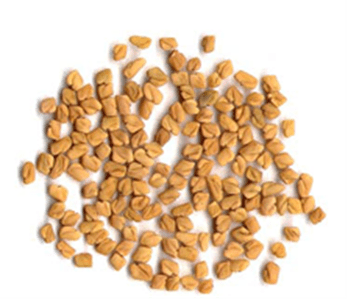
Trigonella foenum-graecum, fenugreek (Hilbe). See the color version of this Figure in Color Plates section (Source: Figure 8.5 from the book)
Trigonella foenum graecum, fenugreek, is extensively cultivated in the Mediterranean region. It is a spice used in Indian cooking and commonly used herb in Ayurveda. Defatted seeds of fenugreek, which are rich in fibre, saponins, and protein, have been described in early Greek and Latin pharmacopoeias as anti-hyperglycaemic. In addition to the seed, other parts of the herb have also been investigated. Therapeutic effects include delay of gastric emptying, slowing carbohydrate absorption, and inhibition of glucose transport from the fibre content, as well as increased erythrocyte insulin receptors and modulation of peripheral glucose utilization. Fenugreek is another herb that was favoured by the Prophet and herbalists for thousands of years.
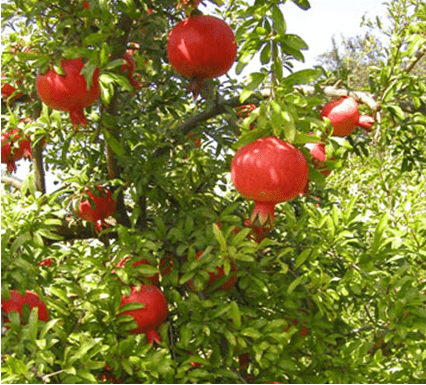
Punica granatum, the pomegranate (Rumman). (Source: Figure 8.17 from the book)
The pomegranate (Punica granatum) is a fruit-bearing deciduous shrub or small tree growing to between five and eight metres tall. This tree is native to the region from Persia to northern India and has been cultivated and naturalized over the whole Mediterranean region and the Caucasus since ancient times. The fruit is covered by a leathery pericarp, contained within are numerous arils, each a single seed surrounded by a translucent juice-containing sac. Thin acrid-tasting membranes extend into the interior of the fruit from the pericarp, providing a latticework for suspending the arils. Pomegranate, especially its fruit, possesses a vast ethnomedical history and represents a phytochemical reservoir of heuristic medicinal value. The tree/fruit can be divided into seven anatomical compartments: seed, juice, peel, leaf, flower, bark, and roots, each of which has interesting pharmacologic activity.
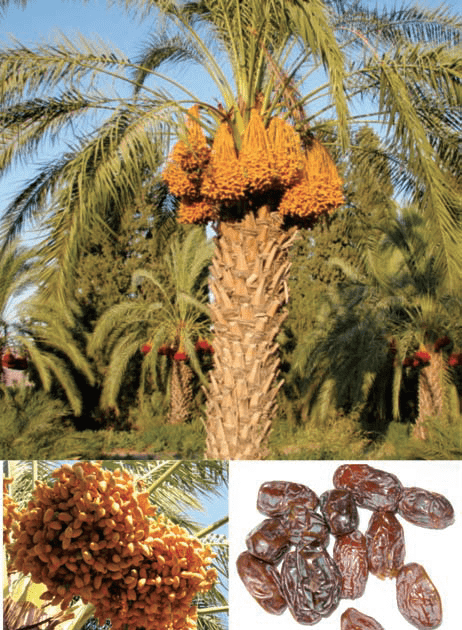
Phoenix dactylifera, date palm and date fruits Rutab (left) and Tamer (right). (Source: Figure 17.1 from the book)
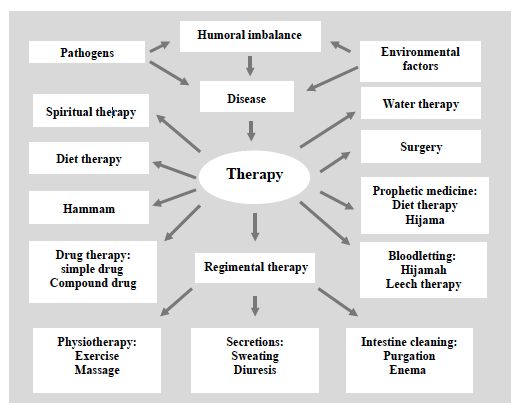
Greco-Arab and Islamic medicine apply three types of herapies. These include the diet, drug, and regimental therapies. The diagnostic parameters of the Greco-Arab medicine include the rate, strength, width, and depth of the pulse and the color, odor, amount of urine and stool. After confirming the cause of the disease, the physician starts the treatment by recommending the diets or drugs that have temperament opposite to the prevailing abnormal temperamental condition of the affected organ or system. (Source: Figure 7.2. from the book)

Commonly used Medicinal plants and their Pharmacological properties (Source: Table 8.1 from the book)
***
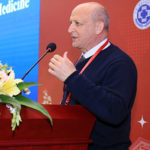
Bashar Saad, PhD, is Professor of cell biology and immunology at the Arab American university in Jenin, Palestine, and at Al-Qasemi Academic College, Baga Algharbiya, Israel. He made a significant contribution in combining cell biology, immunology, and 3D cell culture techniques with Arab-Islamic herbal wisdom. His research interests include antidiabetic, anti-inflammatory and anticancer properties of medicinal plants. He has written more than 150 original papers as well as review articles and book chapters on Arab-Islamic herbal medicine.
***

Omar Said, Phd, is the Chief Research Officer and founder of BeLeaf Pharma. He is a pioneer in the field of Greco-Arab medicine, herbal medicine and pharmacology. He serves as the head of the Arab medicinal plant project in the Galilee Society R&D regional centre, Israel. He has a PhD in Pharmacology. As an expert in the fields of pharmacology and ethnopharmacology, he made a significant contribution in combining this modern science with the medicinal plants’ tradition. His research interests include diabetes, obesity, fertility, psoriasis, acne, hyper-lipidemia, and liver diseases. He has written more than 65 original papers as well as review articles and book chapters on Arab-Islamic herbal medicine.
***
Resources and further reading
- Al-Hassani, Salim, Chief Editor, 1001 Inventions: The Enduring Legacy of Muslim Civilsation. Editor. Forward by HRH Prince Charles. National Geographic, 3d edition, 2012, 352 pages.
- Saad B, Zaid H, Shanak S, & Kadan S, (2017) Anti-diabetes and Anti-obesity Medicinal Plants and Phytochemicals Safety, Efficacy, and Action Mechanisms.
- Shanak S, Saad B, & Zaid H (2019) Metabolic and Epigenetic Action Mechanisms of Antidiabetic Medicinal Plants. Evidence based complementary and alternative medicine Article ID 3583067, Volume 2019 (2019)
- Saad B, (2019) Prevention and Treatment of Obesity-Related Cardiovascular Diseases by Diet and Medicinal Plants. In “Herbal Medicine: Back to the Future, Volume 2: Vascular Health. Edited by Prof. Ferid Murad, Prof. Atta-Ur-Rahman, and Prof. Ka Bian, Bentham, pp 125-165.
- Saad B, (2015) Integrating traditional Greco-Arab and Islamic herbal medicine in research and clinical practice. In Phytotherapies: safety, efficacy, and regulation, Ed. Igbal Ramazan. Wiley-Blackwell John Wiley & Sons, Inc.
- Touzani S, Embaslat W, Imtara H Kmail A, Kadan S, Zaid H , Ilham ElArabi Lyoussi B, Saad B, (2019) “In Vitro Evaluation of the Potential Use of Propolis as a Multitarget Therapeutic Product: Physicochemical Properties, Chemical Composition, and Immunomodulatory, Antibacterial, and Anticancer Properties,” BioMed Research International, vol. 2019, Article ID 4836378, 11 pages, 2019.
***
Book review by Salim T S Al-Hassani, President of the UK based Foundation for Science, Technology and Civilisation (FSTC). This review would have not been accomplished without the assistance of a few members of FSTC, in particular, Dr Sameena Z H Haq, Associate Fellow of FSTC, who is specialised in parasitology and herbal medicine.






















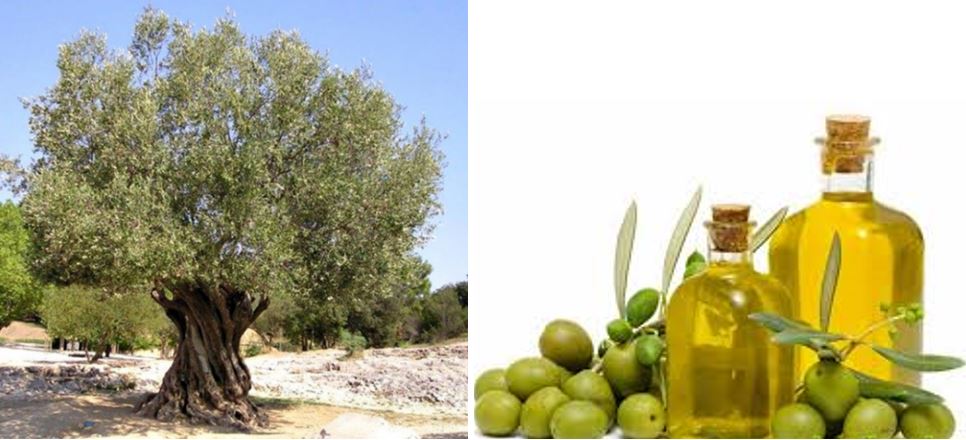
No hay comentarios:
Publicar un comentario